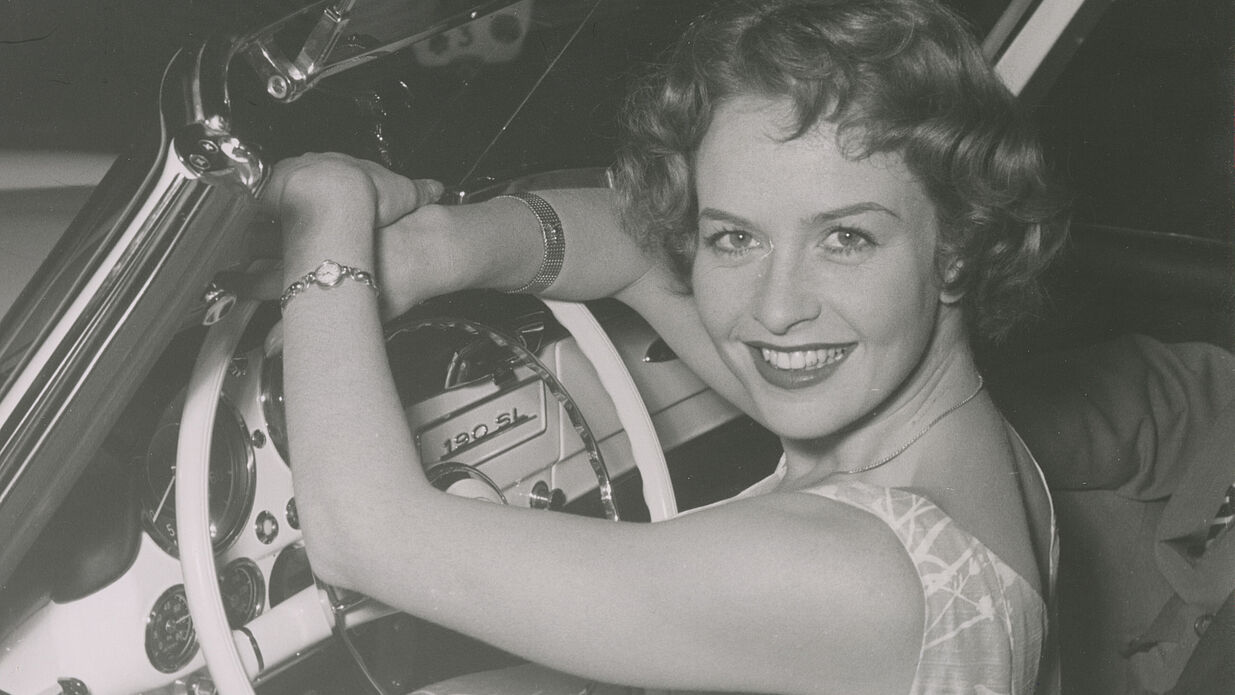A Thousand Stars Aglitter
A Hommage to the Dancer and Actress Germaine Damar

The career of dancer and acrobat Germaine Haeck was so fairytale-like that it could have served as the basis for one of her cinema films. Born on 31 August 1929 in Petingen, Luxembourg, she became an up-and-coming star in German-language entertainment films in the early 1950s on the recommendation of Zarah Leander. Systematically developed as a film actress by Herzog Filmverleih, she made it big under the stage name Germaine Damar - phonetically based on the Hollywood diva Hedy Lamarr. She made her screen debut in 1952 in Géza von Cziffra's Tanzende Sterne.
As a Luxembourger, she became the figurehead of the opulently decorated revue film, which was characterised in German cinema before 1945 by female stars such as Marika Rökk or La Jana and in the 1950s especially by Caterina Valente. Most of her around 30 cinema productions took her behind the scenes of the dance industry. The precarious economic circumstances of theatre people were just as much a theme as the moral reservations of a narrow-minded bourgeois post-war society towards the glamorous, but also frivolous and dubious world of varietés. Black performers often took part in her films, including Olive Moorefield, Marie Nejar (known under the stage name Leila Negra), the Peters Sisters and Kenneth Spencer.
The blonde, dapper, always radiant Germaine Damar fitted in perfectly with the optimistic zeitgeist of the Wirtschaftswunder era. She was the chorus girl on duty. Focussed on the image of the nice girl next door, she stood in front of the camera with audience favourites such as Peter Alexander, Vico Torriani, Heinz Erhardt, Walter Giller, Georg Thomalla, Joachim Fuchsberger and Claus Biederstaedt. She either played young women from lower middle-class backgrounds for whom the dream of an engagement in variety theatre came true. Or she portrayed established revue dancers who longed for a middle-class existence as a wife and mother - happy endings guaranteed.
In the 1950s, Germaine Damar was one of the most popular film stars in West Germany. She had fan clubs, also filmed in France alongside Bourvil and Michel Piccoli, went on theatre tours with Willy Birgel, before she finally speculated with an investment in her film project Glück und Liebe in Monaco (1959). By this time, the wave of revue films, with which she was completely identified, had already ebbed away. Having become popular in South America through her film Die Beine von Dolores (1957), she ended her career in the early 1960s with several personality shows on Argentinian television.
On 31 August 2024, Germaine Damar, who the Frankfurter Allgemeine Zeitung called "The Blonde Rocket" in 1958, celebrates her 95th birthday at her current home in Florida. This tribute is dedicated to her and her films, which seem to have fallen out of time. On the one hand, they reflect the wishes and dreams of young women in the immediate post-war period and convey social role models that seem very alien to us today. On the other hand, they offer great spectacle and pure viewing pleasure. (Michael Wenk)
The hommage to Germaine Damar is a collaboration with the Maison du Grand-Duché de Luxembourg at the Embassy of the Grand Duchy of Luxembourg and is the brainchild of filmmaker Michael Wenk.
Germaine Damar – Der tanzende Stern
Germaine Damar – Der tanzende Stern
LU 2011, R: Michael Wenk, 60' · DigiBeta
DO 05.09. um 18 Uhr (Einlass um 17.30 Uhr) in der Maison du Grand-Duché de Luxembourg (Botschaft des Großherzogtums Luxemburg, Klingelhöferstr. 7, 10785 Berlin) · Filmgespräch mit Michael Wenk
Der Titel „Der tanzende Stern“ spielt auf das 1952 erschienene Kinodebut der Luxemburgerin Germaine Damar an, die in der Nachkriegszeit zum Star des deutschsprachigen Revuefilms wurde. In Michael Wenks Dokumentation blicken Damar sowie Kollegen wie Walter Giller, Sonja Ziemann, Claus Biederstaedt und Joachim Fuchsberger auf die choreografisch wie finanziell herausfordernden Produktionsbedingungen dieser opulent ausgestatteten Produktionen zurück. „Wenk stellt Fragen: Wie wurde die Luxemburger Tänzerin Germaine Haeck von der westdeutschen Filmindustrie als Nachwuchsdarstellerin aufgebaut und schließlich zum Massenidol Germaine Damar? Und was hat ihr Erfolg mit dem Genre des Revuefilms zu tun?“ (Daniel Conrad, Luxemburger Wort, 15.12.2011).
Eine Anmeldung zur deutschen Erstaufführung des Films ist erforderlich unter https://berlin.mae.lu/de/culture.html
Eintritt frei.




